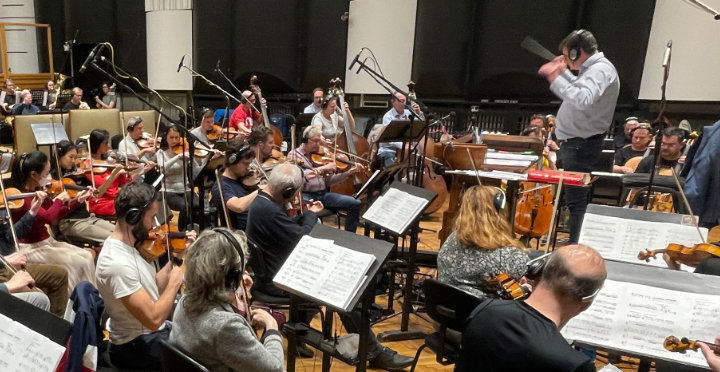Part Three: Vincent's Theme

This is Part 3 in our harmonic investigation of music from Final fantasy VII. If you haven’t checked out Part 1 click the link HERE, and for Part 2 click HERE
Continuing the trend, we shall be examining the theme music used for specific characters from the game, and seeing what we can learn. This week: Vincent’s Theme, called ‘The Nightmare Begins’.
I chose this piece to analyse because it is so different to Aerith’s Theme and Tifa’s Theme, both melodically and (more importantly) harmonically. Where those two pieces are quite standard, in that there is a clearly defined melody moving above a chord progression, in this piece there is no real distinction between melody and harmony as the tune is essentially all arpeggios, meaning the notes of the chords are played in sequence, not simultaneously. The piece also drastically differs in its tone, with a dark, haunting sound. This is created through its dissonant and ambiguous harmony.
The very first bar of music establishes the key, albeit with a rather dissonant extension, for this is a D minor major seventh chord. Just to be clear, a minor major seventh chord is a minor seventh chord with a major seventh on top, which in this case is the C#.

There are a couple of different contexts in which minor major seventh chords are commonly found. Often, at some climactic moment of resolution in a minor key piece of music, most likely the end cadence, the major seventh will linger over the tonic minor chord before finally resolving upwards. This is exactly what happens in the final chorus from Bach’s ‘St Matthew Passion’, and is a technique that Bach uses often.
Another way in which minor major seventh chords commonly crop up is as part of some descending melodic sequence over a minor chord. This happens in many jazz standards. For example, if you have a melody line over a D minor chord that starts on D and descends in semitones through C sharp, C natural and B natural, the chord progression will be: D minor, D minor major 7, D minor 7, D minor 6. That is exactly what happens in this piece of music, except that we have started on the D minor major seventh, and the chords are played as arpeggios rather than block chords, with one note in the arpeggio descending by a semitone every two bars.
It’s also worth noting that the D minor 6th is another chromatic chord in this opening sequence, seen here. Just to be clear, a minor sixth chord is a minor triad with a major sixth on top.

There are two key things to be learned here:
1: An easy way of adding some chromaticism to your music can be as simple as adding extensions to your chords when appropriate (in a minor key the sixth of the scale is diatonically minor, so a minor 6th chord on your tonic or 1st scale position is chromatic).
2: You don’t have to think entirely in block chords and the simultaneity of notes when thinking about your harmony. You can think about how the melodic lines will change the harmony by moving through it.
Moving on, something similar happens in the next section. We have another repeated arpeggio, with one note in the sequence changing. The notes that stay constant are D, F# and C#. (The C# is sometimes notated as a D♭ to minimise the amount of accidentals needed and make the sequence easier to read. This is sometimes referred to as 'false notation') These three notes would typically make a major seventh chord with the fifth omitted (in this instance it would be an A). However the additional note in the sequence, the C natural, renders the harmony ambiguous, as we now have the minor seventh and major seventh in the same chord.

Would this be a major seventh chord with an added minor seventh? Or vice versa? Or neither? Or both? It’s the harmonic ambiguity here that creates such an unsettling sound. Sometimes the harmonic function of a note can be to create ambiguity. When trying to compose a nice piece of music this is the sort of thing you would want to avoid, but if you are deliberately going for that unsettling sound it can work very well.
So here’s another key point to take away from this: whether or not something musically ‘works’ absolutely depends on the sound you are trying to create. There are many typically ‘nice’ and pleasant chord patterns that wouldn’t work here at all, because that is not the tone or atmosphere this music is trying to create. Vincent, the character this theme music is used for, is a brooding character found sleeping in a coffin in the basement of a creepy mansion full of monsters. The pleasing harmony of Tifa’s or Aerith’s themes would not work well at all.
Well that just about wraps up this blog, and our short series on Final Fantasy VII. We’ve now looked through quite a few harmonic devices and chromatic chord patterns used throughout the soundtrack, and these are techniques that you can now use to spice up your harmony. If you read through all of the blogs, hopefully you enjoyed them and you learned something too. If you have any suggestions about topics you would like covered in future blogs, feel free to let us know in the comments!
If you enjoyed this make sure you check out our other blogs, and stay tuned for more. If you’re serious about furthering your knowledge and your career in music, check out our Postgraduate and Premium courses on our website and see which ones are suitable for you. We’re always happy to help, so send us an email at contact@thinkspace.ac.uk with any questions and we’ll get back to you. Click the button below to take a look at our premium courses now.









































